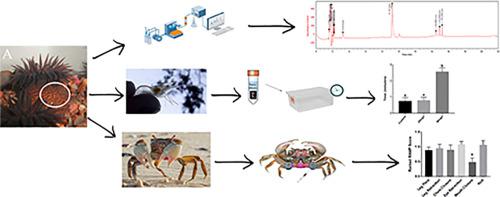Comparative Biochemistry and Physiology C: Toxicology & Pharmacology ( IF 3.9 ) Pub Date : 2020-11-18 , DOI: 10.1016/j.cbpc.2020.108941 Claudio Luis Quaresma Bastos Junior 1 , Tatiane Senna Bialves 1 , Kamila Foguesatto 1 , Estevão Melo Arantes 2 , Gleidson Barcelos de Souza 3 , Thiago Obiedo Garcia 3 , Antonio Sergio Varela 3 , Robert Tew Boyle 4

|
Sea anemones of the genus Bunodosoma possess along their body column, longitudinally arranged brown-colored vesicles. We have shown that in B. cangicum, these warty structures contain a mixture of potent toxins. This work highlights the neuro-inhibitory effects exhibited by two decapod crustacean species exposed to the extracts from these vesicles. For this, we use the unrefined toxin in doses, exposure times, and different exposure pathways. The findings show that at least one neuro-inhibitory compound is present and remains active regardless of the exposure method or dose tested. This toxin affects neuro-motor pathways but not neuro-sensory pathways. Shrimp exposed to toxin could continue to perceive and track food pellets but could not secure and consume their ration. Of six anatomical reflexes tested under the toxin's influence, voluntary movements of the mouthparts were impacted most commonly. Interestingly, all subject animals recovered from the toxin exposure within 2 h. Finally, we propose Reflexive Action Analysis (RAMP) as a tool to evaluate the potency of other neurotoxic or neuro-inhibitory compounds in crustacea. This work is the first to show the neuro-inhibitory activity of extracts from these sea anemone columnar vesicle structures and the first to evaluate these effects using RAMP reflex analysis.
中文翻译:

海葵罐头中的囊泡毒素对淡水虾阿根廷龙虾和岸蟹新螺旋藻行为的影响
Bunodosoma属的海葵沿着它们的身体柱拥有纵向排列的棕色囊泡。我们已经证明在B. cangicum中,这些疣结构含有强力毒素的混合物。这项工作强调了暴露于这些囊泡提取物中的两种十足纲甲壳类动物所表现出的神经抑制作用。为此,我们在剂量,暴露时间和不同的暴露途径中使用未精制的毒素。研究结果表明,至少有一种神经抑制化合物存在,并且无论其暴露方法或所测试的剂量如何,其均具有活性。这种毒素影响神经运动通路,但不影响神经感觉通路。暴露于毒素的虾可以继续感知和追踪食物颗粒,但无法固定和消耗其定量。在毒素的影响下测试的六个解剖反射中,口器的自发运动受到的影响最大。有趣的是,所有受试者动物均在2小时内从毒素暴露中恢复过来。最后,反射动作分析(RAMP)作为评估甲壳动物中其他神经毒性或神经抑制化合物功效的工具。这项工作是第一个显示来自这些海葵柱状囊泡结构的提取物的神经抑制活性,也是第一个使用RAMP反射分析评估这些作用的方法。











































 京公网安备 11010802027423号
京公网安备 11010802027423号